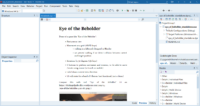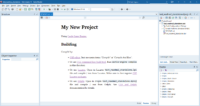 |
 |
I’m back from the Polish conference Zlot Programistów Delphi with lots of positive feedback and energy. This energy will result in something tangible in CGE — I decided to work on a new Delphi platform (Delphi + Linux) immediately, and already made good progress in delphi-linux branch!
From more Delphi-specific news: we now support Delphi IDE “welcome page of a project” that allows to prominently display a file, like README.md in Markdown, when one opens a project in Delphi. This makes projects look prettier in Delphi, and it makes total sense for us — since our templates and most examples already define a README.md.
I have also made big rearrangement in our installation docs. The installation page is now shorter than ever, reflecting our effort to make things “just work out-of-the-box when you install the engine”. In turn, there’s a dedicated page about Delphi support and Lazarus support. The ever-important editor page also got a number of updates.
Finally, I wanted to mention a big new pull request submitted by Andrzej Kilijański this week: New physics based first/third person 3d and platformer like modular navigation + input axis and others. Reviewing it, finishing touches and merging is our big focus now, because it brings a lot of critical features we talked about and carefully designed in recent months:
-
It’s a set of behaviors that allow to easily set up a working navigation. Navigation for a large set of games — 1st-person FPS, 3rd-person, 2D games (like platformer) and more. Effectively, it will replace most of usage of our navigation components. The new behaviors attach to
TCastleTransform(so they can “drive” a camera and/or a transformation hierarchy with some visible player), they are modular (so you can use and customize a subset of them, you can also add/remove some abilities to player at runtime), they are flexible (you can easier replace pieces of them with custom code). -
Connected to above, there’s also (initial design of)
TCastleAxis, a great new approach to monitor inputs in CGE. It allows to easily query keys, mouse look and more from update events and behaviors. The core use-case is somewhat analogous to how you use inputs in Unity or Godot (though our design isn’t a clone, but we looked at competition to se what they offer and how we can even improve that 🙂 ). -
Connected to above, there’s also Kraft update. It brings a few improvements, I want to highlight a new feature expose in CGE: “sphere cast”,
TCastleRigidBody.PhysicsSphereCast.
See the pull request description for docs. We welcome your feedback about the ideas described there, we welcome your tests of the branch of that PR.
As always, have fun creating games with Castle Game Engine and we appreciate if you can support us on Patreon!